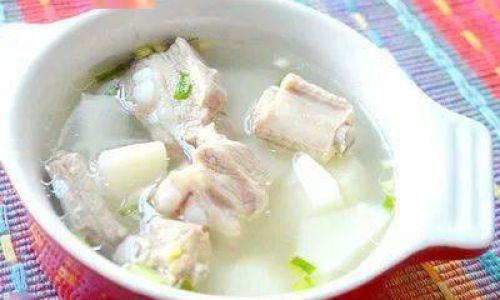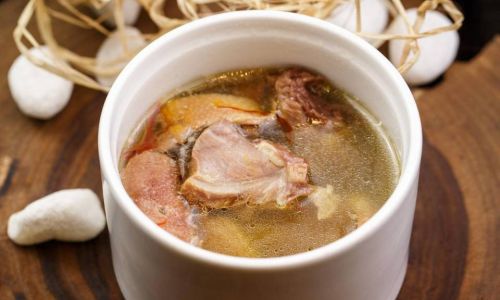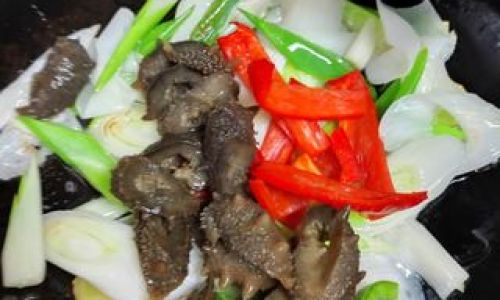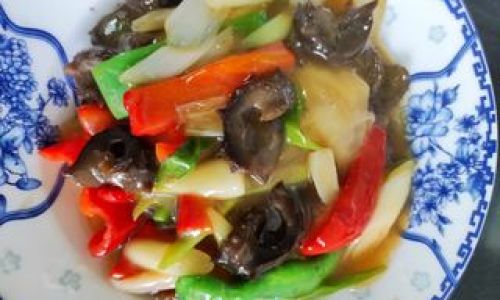Introduction
In the realm of traditional Chinese cuisine, soup-making is an art form that blends flavor, texture, and health benefits into a single bowl. Among the myriad of soups that grace dining tables, Lily Bulb, Chinese Yam, and Spare Ribs Soup stands out as a timeless classic. This delicate yet hearty broth combines the earthy sweetness of Chinese yam, the subtle floral notes of dried lily bulbs, and the rich umami depth of pork ribs. Beyond its culinary appeal, this soup is revered for its therapeutic properties, rooted in the principles of Traditional Chinese Medicine (TCM). It is a dish that nourishes the body, soothes the soul, and connects generations through shared culinary heritage.
The Star Ingredients: A Trio of Nutritional Powerhouses
To understand the allure of this soup, one must first appreciate the individual ingredients that compose it. Each component brings unique qualities to the table, both in terms of taste and health benefits.
-
Lily Bulbs (Bai He)
Dried lily bulbs, or Bai He in Mandarin, are the flowering buds of the lily plant (Lilium brownii), harvested and dried for culinary and medicinal use. In TCM, lily bulbs are prized for their ability to moisten the lungs, clear heat, and calm the spirit. They are often recommended for alleviating coughs, reducing restlessness, and promoting restful sleep. Nutritionally, lily bulbs are rich in polysaccharides, which support immune function, and contain mild amounts of vitamins B and C. Their texture, when simmered, becomes tender and slightly gelatinous, adding a unique mouthfeel to the soup. -
Chinese Yam (Shan Yao)
Chinese yam, or Dioscorea opposita, is a tuberous root vegetable celebrated for its mild, starchy flavor and numerous health benefits. In TCM, it is believed to tonify the spleen, nourish the stomach, and replenish vital energy (qi). Modern nutrition highlights its high fiber content, which aids digestion, and its profile of antioxidants, including vitamins A and C. When cooked, Chinese yam softens into a creamy texture, thickening the broth slightly and imparting a subtle sweetness that balances the savory notes of the meat. -
Spare Ribs (Pai Gu)
Pork spare ribs serve as the soup’s flavor foundation, providing collagen-rich broth that becomes silky after prolonged simmering. In TCM, pork is considered a yin-nourishing food, meaning it cools and moistens the body, making it ideal for balancing internal heat. Nutritionally, spare ribs offer protein, B vitamins, and minerals like iron and zinc. Roasting or blanching the ribs before cooking removes excess fat, resulting in a cleaner, clearer broth.
The Synergy of Flavors and Health Benefits
The magic of this soup lies in the harmony of its ingredients. Lily bulbs contribute a light, floral aroma that lifts the broth’s earthiness, while Chinese yam adds a comforting sweetness. The spare ribs provide a savory backbone, creating a balance that is both satisfying and restorative.
From a health perspective, the combination is equally harmonious. Lily bulbs and Chinese yam work synergistically to support respiratory and digestive health, while the collagen from the ribs promotes joint and skin elasticity. This soup is often recommended for individuals recovering from illness, as it is gentle on the stomach and easy to digest. Its moistening properties also make it suitable for dry climates or seasonal transitions when the body craves hydration and nourishment.
Culinary Preparation: A Step-by-Step Guide
Creating the perfect pot of Lily Bulb, Chinese Yam, and Spare Ribs Soup requires patience and attention to detail. Here’s a detailed guide to crafting this beloved dish:
Ingredients (Serves 4–6):
- 500g pork spare ribs, cut into 2-inch pieces
- 100g dried lily bulbs (soaked in warm water for 30 minutes, drained)
- 200g Chinese yam, peeled and sliced into 1-inch chunks
- 8–10 red dates (jujubes), pitted
- 3–4 slices fresh ginger
- 5 liters water
- 1 tsp wolfberries (goji berries), optional
- Salt to taste
Instructions:

-
Parboil the Ribs:
Place the spare ribs in a pot of cold water, bring to a boil, and simmer for 2–3 minutes. Drain and rinse under cold water to remove impurities. This step ensures a clear broth. -
Prepare the Aromatics:
Soak the dried lily bulbs until soft. Peel and slice the Chinese yam, submerging it in water to prevent browning. Smash the ginger slices lightly to release their flavor. -
Assemble the Soup:
In a large pot, combine the parboiled ribs, lily bulbs, Chinese yam, red dates, and ginger. Add water and bring to a boil over high heat. -
Simmer Gently:
Once boiling, reduce the heat to low and simmer uncovered for 1.5–2 hours. Skim off any foam that rises to the surface. The longer the simmer, the richer the broth. -
Final Touches:
Add wolfberries (if using) during the last 15 minutes of cooking. Season with salt to taste.
-
Serve:
Ladle the soup into bowls, ensuring each serving includes ribs, yam, lily bulbs, and broth. Garnish with chopped cilantro or green onions if desired.
Culinary Tips for Perfection:
- Soak Lily Bulbs Properly: Dried lily bulbs require adequate rehydration to soften. Soak them in warm—not hot—water to preserve their texture.
- Avoid Overcooking Yam: Chinese yam becomes mushy if simmered too long. Add it during the initial cooking phase to let it absorb flavors without disintegrating.
- Enhance Flavor with Red Dates: Red dates add natural sweetness and depth. For a richer broth, use homemade chicken or pork stock instead of water.
Cultural Significance and Modern Adaptations
This soup has deep roots in Chinese family traditions, often prepared during festivals, family reunions, or convalescence. It symbolizes care and nourishment, embodying the TCM principle of “yao shi tong yuan”—the belief that food and medicine share the same origin.
In modern times, chefs and home cooks alike have adapted the recipe to suit contemporary tastes and dietary needs. Vegetarian versions replace pork with mushrooms or tofu, while gluten-free adjustments omit red dates or use alternative sweeteners. Some recipes incorporate modern twists, such as adding carrots or corn for extra sweetness, or garnishing with fried garlic for crunch.
The Science Behind the Soup’s Therapeutic Effects
While TCM attributes the soup’s benefits to balancing yin and yang, modern nutrition science offers insights into its physiological impacts:

- Collagen and Joint Health: The prolonged simmering of pork ribs breaks down collagen into gelatin, which supports joint mobility and skin hydration.
- Fiber and Digestion: Chinese yam’s dietary fiber aids gut health, promoting regularity and preventing constipation.
- Antioxidant-Rich Lily Bulbs: Polysaccharides in lily bulbs exhibit anti-inflammatory and immune-boosting properties, potentially reducing oxidative stress.
Beyond the Bowl: Pairing Suggestions
This soup pairs beautifully with steamed rice, stir-fried greens, or glutinous rice dumplings. For a complete meal, serve it alongside light dishes like garlic-sautéed bok choy or tofu with century eggs. The soup’s mild flavor profile also complements spicier dishes, offering a cooling contrast.
Conclusion: A Timeless Elixir
Lily Bulb, Chinese Yam, and Spare Ribs Soup is more than a meal—it is a testament to the enduring wisdom of traditional cuisine. Its ability to harmonize flavor, nourish the body, and soothe the spirit makes it a cherished dish across generations. Whether enjoyed on a chilly evening or shared with loved ones during celebrations, this soup remains a comforting reminder of the interconnectedness of food, health, and culture. As modern life accelerates, this humble bowl of broth invites us to slow down, savor the moment, and nourish ourselves from the inside out.





0 comments